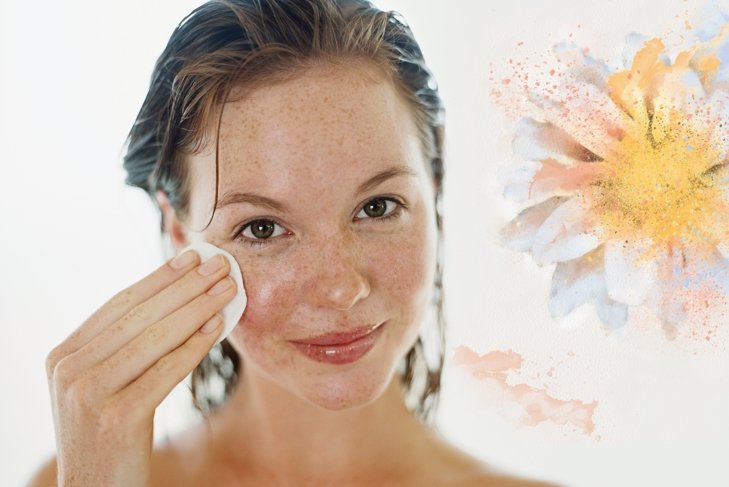
Facial cleansing has taken a turn away from harsh face washes, in favour of gentle natural cleansers. Learn how to include cleansing oils, lotions, balms, and waters in your facial routine.
While many of us celebrate the beginning of the New Year in January, there’s something about springtime that feels like a true fresh start. This year, why not extend spring cleaning to your skin care products by revamping your cleansing routine?
Gently does it
Recently, facial cleansing has taken a turn away from harsh, sudsy face washes to trendy, gentle natural cleansers that are often free from soap or water. And our complexions are thanking us for it!
It turns out that many conventional facial cleansers are made with aggressive surfactants (cleansing chemicals) that penetrate and degrade the skin’s healthy barrier. This, in turn, makes us more susceptible to skin conditions such as inflammation, dryness, irritation, redness, and discomfort. Rather than stripping our skin’s natural, healthy oils and bacteria (yes, our skin, like our guts, feature healthy flora), gentle facial cleansing supports our skin by keeping the skin barrier intact.
Gentle skin cleansers include cleansing oils, lotions, balms, and waters.
Choosing a moisturizing oil
Selecting a facial oil can seem daunting, but oftentimes, a little label reading is all that’s necessary. Here are some tried-and-true favourites.
For dry or mature skin
Nourishing facial oils perfect for quenching skin’s thirst include rosehip and olive oil blends, or coconut oil.
For sensitive skin
Sweet almond oil is particularly soothing for those with sensitive skin, except for those with a nut allergy.
For combination or normal skin
This skin type can benefit from a lightweight oil such as argan or jojoba.
For oily or blemish-prone skin
Blends of oils tailored to those with oily or acneic skin can include calendula and almond oil. Grapeseed oil is also ideal for balancing troubled skin.
Cleansing oils
Not only are oils wonderful skin moisturizers (see “Choosing a Moisturizing Oil” to learn more), but they can also be used for cleansing. Although it may sound counterintuitive to use oil to cleanse the face, cleansing oils have become wildly popular and are celebrated by beauty buffs and natural health advocates alike. The method to this apparent madness is the chemistry principle “like dissolves like”; therefore, oil in a product dissolves the oil on our skin.
Who it’s for
Oil cleansing can be used by people with all skin types—yes, even by those with oily skin. Just make sure that the product states on the label which skin type it’s targeted for.
How to use it
As always, follow the label. Generally, cleansing oil should be massaged into a dry face in a circular motion, and then rinsed off with water and a soft washcloth.
What to look for
Cleansing oils can be pure oils, such as jojoba oil or sunflower oil, or blends of oils formulated for different skin types. But don’t be fooled by the imposters—not all cleansing oil products on the market are natural. Shop at your local natural health retailer, and choose products made from plant or nut oils (not mineral oils) that don’t contain added chemicals.
Cleansing lotions
Also called cleansing milks, creamy cleansing lotions are a gentle, nourishing way to cleanse skin without stripping away moisture.
Who it’s for
Cleansing lotions can be used on even the most sensitive or dry skin.
How to use it
Oftentimes, cleansing lotions don’t need to be rinsed off—simply using a clean cotton pad or washcloth is enough—so they’re perfect for busy mornings. However, they may not be ideal for removing heavy makeup without rinsing.
What to look for
Look for soothing ingredients that help support skin health, including sweet almond oil, glycerin, jojoba oil, or sesame seed oil.
Cleansing balms
Relative newcomers to the facial cleansing game, these unique products transform from balm to oil during the cleansing process, and work to gently cleanse skin. They’re also a dream at removing makeup.
Who it’s for
As with cleansing oils, there’s a cleansing balm out there for everyone and every skin type—from dry to oily. Again, be sure to read the label and choose a product suited to your unique needs.
How to use it
Cleansing balms can seem like a messy affair, but they’re really quite simple. Typically, they’re applied to a damp face, and emulsify into a creamy cleanser when massaged into the skin. Then they’re rinsed off with water and a soft washcloth.
What to look for
Nourishing ingredients in facial cleansing balms include sweet almond oil, shea butter, olive oil, camomile, lavender, and lemon.
Cleansing waters
Also known as micellar water, cleansing water is a French beauty staple that has become popular in North America relatively recently. Without becoming too technical, the term “micellar” simply means that gentle cleansers are suspended in a liquid. The result is a refreshing and cooling cleansing experience that calms skin and removes makeup.
Who it’s for
Anyone can use micellar water; however, like the other cleansers in this article, they’re particularly suited to sensitive skin.
How to use it
Like cleansing lotions, micellar waters are straightforward to use. Just soak a cotton ball in the liquid and sweep across the face. There’s no need to rinse afterward, making them ideal for travel or on-the-go use.
What to look for
Micellar waters are so commonplace that it’s important to read ingredient lists carefully; steer clear of preservatives, mineral oil, and phthalates. Key ingredients to look for include glycerin, aloe, and natural extracts (such as grape, cucumber, and camomile).
What about toner?
Many people wonder whether or not adding toner to their facial care routine is beneficial. In general, yes, a toner can be very beneficial.
Toners can help remove any impurities, such as traces of dirt or makeup that your cleanser might have left behind. Equally important, they can help restore the healthy pH of skin. Just be sure to choose a toner that doesn’t contain alcohol, which can be drying.













